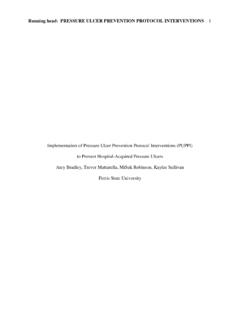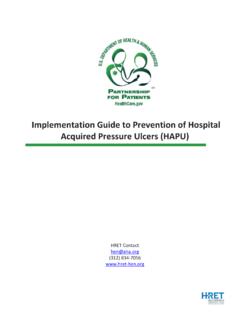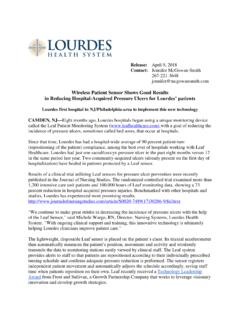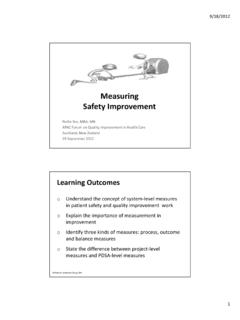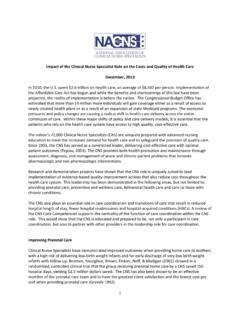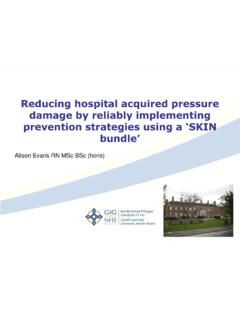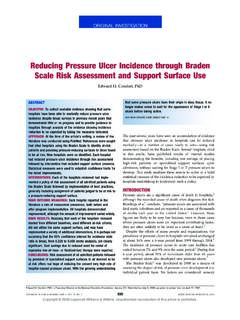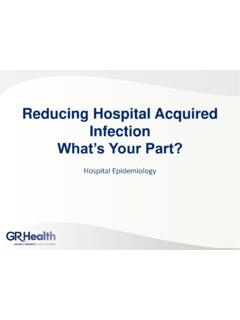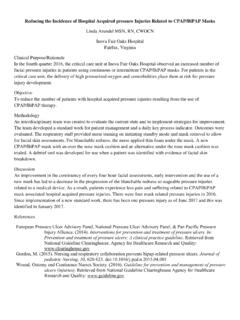Transcription of Virtual Breakthrough Series, Part 1: Preventing …
1 485 The Joint Commission Journal on Quality and Patient Safety Performance Improvement Virtual Breakthrough Series, Part 1: Preventing Catheter-Associated Urinary Tract Infection and hospital - acquired pressure Ulcers in the Veterans Health Administration Lisa Zubkof, PhD; Julia Neily, RN, MS, MPH; Beth J. King, RN, BSN, MA, CCM; Mary Ellen Dellefeld, PhD, RN; Sarah Krein, PhD, RN; Yinong Young-Xu, PhD; Shoshana Boar, MS; Peter D. Mills, PhD, MS Preventing hospital - acquired conditions (HACs) is an important aspect of providing high-quality and safe care so much so that the Centers for Medicare & Medicaid Services (CMS) has specifically noted Preventing HACs as a top ,2 To support these efforts CMS developed programs to limit paying for preventable ,4 Recent work by Wang et al.
2 Indicates that these conditions are declining;5 however, continued improvement is still neces-sary and Preventing health care associated infections (HAIs) remains one of the Joint Commission National Patient Safe-ty Ideally, hospitals could implement improvement efforts to address all conditions at once. Building on current expertise and existing efforts in the Veterans Health Adminis-tration (VHA) of the Department of Veterans Affairs (VA), we decided to implement a Virtual Breakthrough Series (VBTS) col- laborative focused on two of these conditions: reducing catheter-associated urinary tract infections (CAUTIs) and hospital - acquired pressure ulcers (HAPUs).
3 5 Previous quality improve-ment efforts in the VHA on these topics have focused on data feedback to prompt change, whereas the VBTS model uses active personalized coaching and group education to facilitate successful implementation of interventions. Preventing HAIs is an area of concern in patient safety. Uri-nary tract infections have been identified as one of the most frequent HAIs,7 with the majority of these infections related to the use of urinary ,8 Indeed, CAUTI is a common HAI, affecting hospitalized patients ,9,10 Moreover, bacteriuria, a common occurrence among catheterized patients, can lead to bloodstream infections,11 as well as contribute to the inappropriate use of antibiotics.
4 12 which in turn supports the development of multidrug-resistant Despite some progress in reducing CAUTI rates in the Unit-ed States and in a number of other countries,7,14,15 there are still opportunities for ,10,16 In fact, CMS has identi-fied treatment for CAUTI as one of the conditions for which Article-at-a-Glance Background: In 2014 the Veterans Health Administration (VHA) of the Department of Veterans Affairs (VA) imple-mented a Virtual Breakthrough Series (VBTS) collaborative to help VHA facilities prevent hospital - acquired condi-tions: catheter-associated urinary tract infection (CAUTI) and hospital - acquired pressure ulcers (HAPUs).
5 Methods: During the prework phase, participating facilities assembled a multidisciplinary team, assessed their current sys-tem for CAUTI or HAPU prevention, and examined baseline data to set improvement aims. The action phase consisted of educational conference calls, coaching, and monthly team re-ports. Learning was conducted via phone, web-based options, and e-mail. The CAUTI bundle focused on four key princi-ples: (1) avoidance of indwelling urinary catheters, (2) proper insertion technique, (3) proper catheter maintenance, and (4) timely removal of the indwelling catheter.
6 The HAPU bundle focused on assessment and inspection, pressure -relieving sur-faces, turning and repositioning, incontinence management, and nutrition/hydration assessment and intervention. Results: For the 18 participating units, the mean aggre-gated CAUTI rate decreased from during the prework phase to per 1,000 catheter-days during the action (im-plementation) phase (p < ); the rate did not change for CAUTI nonparticipating sites. HAPU data were available only for 21 of the 31 participating units, whose mean aggre-gated HAPU rate decreased from to from prework to continuous improvement (p < ).
7 Staff education and documentation improvement were the most frequently im-plemented changes. Conclusion: This project helped improve CAUTI and HAPU rates in the VHA and presents a promising model for implementing a Virtual model for improvement. _____November 2016 Volume 42 Number 11 Copyright 2016 The Joint CommissionThe Joint Commission Journal on Quality and Patient SafetyVolume 42 Number 11 November 2016486 Copyright 2016 The Joint Commissionhealth care providers will not be ,17,18 CAUTI rates in many developing countries are substantially higher than those in the United States,9,16 where the decrease in CAUTI rates has not been observed across all hospital locations and Moreover.
8 Although emerging evidence suggests that targeted programs focusing on the use of key practices can be a vital strategy for CAUTI prevention,15,19,20 how best to implement such programs remains an important question. pressure ulcers are among the most common clinical condi-tions found in hospitalized and long-stay patients. Each year, an estimated million pressure ulcers are treated in acute care in the United 23 The incidence and prevalence of pres-sure ulcers varies by clinical 23 Prevalence rates in hospitals have ranged between 1% and 5%.
9 24 27 In nursing homes, 14% to 24% of patients have pressure ulcers on admission. pressure ulcers are associated with increased morbidity, mortality, and patient ,27 Recent reviews have found that effective prevention efforts include special support surfac--es, along with a multicomponent strategy such as a team approach, use of skin champions, staff education, and audit and ,28 The VHA has focused on pressure ulcer prevention in all clin-ical settings, including inpatient, outpatient, mental health, the operating and procedure centers, and nursing homes.
10 Efforts to improve pressure ulcer prevention in the VHA have been made on the local, regional, and national level, with special emphasis on the interprofessional dimensions of effective pressure ulcer prevention. Nonetheless, HAPU prevention remains a high pri-ority issue for the The purpose of the study described in this article is to describe the approaches and experiences of hospitals within the VHA sys-tem that participated in a CAUTI and HAPU prevention VBTS collaborative. This article is only the second, in addition to Neily et al.,30 to compare the outcomes of VBTS collaborative partici--pants to nonparticipants during the same time frame for a clinical topic (CAUTI).
